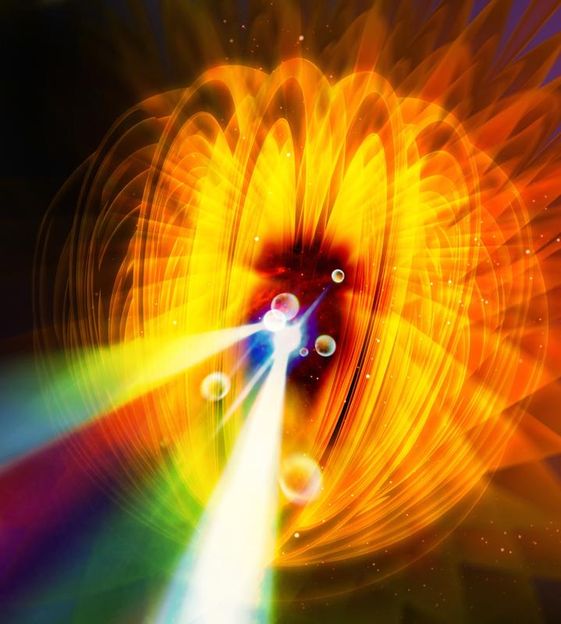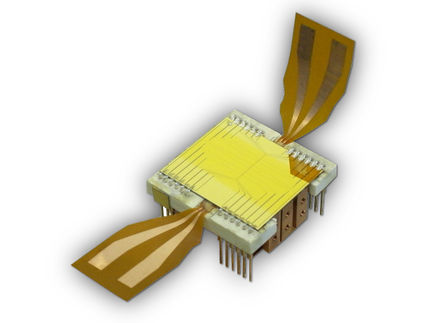Exploring the phenomenon of superconductivity
Fermions in flatland pair up at very high temperatures: Physicists find evidence of an exotic state of matter
Using ultracold atoms, researchers at Heidelberg University have found an exotic state of matter where the constituent particles pair up when limited to two dimensions. The findings from the field of quantum physics may hold important clues to intriguing phenomena of superconductivity.
Superconductors are materials through which electricity can flow without any resistance once they are cooled below a certain critical temperature. The technologically most relevant class of materials, with exceptionally high critical temperatures for superconductivity, is poorly understood so far. There is evidence, however, that in order for superconductivity to occur, a certain type of particles – the fermions – must pair up. Moreover, research has shown that materials which become superconducting at relatively high temperatures have layered structures. “This means that electrons in these systems can only move in two-dimensional planes”, explains Prof. Dr Selim Jochim of Heidelberg University’s Institute for Physics, who heads the project. “What we did not understand until now was how the interplay of pairing and dimensionality can lead to higher critical temperatures.”
To explore this question, researchers at the Center for Quantum Dynamics performed experiments in which they confined a gas of ultracold atoms in two-dimensional traps which they created using focused laser beams. “In solid-state materials like copper oxides, there are many different effects and impurities that make these materials difficult to study. That is why we use ultracold atoms to simulate the behaviour of electrons in solids. This allows us to create very clean samples and gives us full control over the essential system parameters”, says Puneet Murthy, a PhD student at the Center for Quantum Dynamics at Heidelberg University and one of the lead authors of this publication.
Using a technique known as radio-frequency spectroscopy, the researchers measured the response of the atoms to a radio-wave pulse. From this response, they could tell exactly whether or not the particles were paired and in what way. These measurements were also performed for different strengths of interaction between fermions. In the course of the experiments, the researchers discovered an exotic state of matter. Theory states that fermions with a weak interaction should pair up at the temperature at which they become superconductive. However, when the scientists increased the interaction between fermions, they found that pairing occurred at temperatures several times higher than the critical temperature.
“To achieve our ultimate goal of better understanding these phenomena, we will start with small systems that we put together atom by atom”, says Prof. Jochim. The research project also involved scientists from Heidelberg University’s Institute for Theoretical Physics and from Simon Fraser University in Vancouver (Canada).
Original publication
Original publication
P. A. Murthy, M. Neidig, R. Klemt, L. Bayha, I. Boettcher, T. Enss, M. Holten, G. Zuern, P. Preiss, S. Jochim; "High Temperature Pairing in a strongly interacting two-dimensional Fermi gas"; Science; published online on 21 December 2017
Topics
Organizations
Other news from the department science

Get the chemical industry in your inbox
By submitting this form you agree that LUMITOS AG will send you the newsletter(s) selected above by email. Your data will not be passed on to third parties. Your data will be stored and processed in accordance with our data protection regulations. LUMITOS may contact you by email for the purpose of advertising or market and opinion surveys. You can revoke your consent at any time without giving reasons to LUMITOS AG, Ernst-Augustin-Str. 2, 12489 Berlin, Germany or by e-mail at revoke@lumitos.com with effect for the future. In addition, each email contains a link to unsubscribe from the corresponding newsletter.
Most read news
More news from our other portals
Last viewed contents

Process for the optical analysis of trace gases optimised - Prof. Gernot Friedrichs from Kiel University has developed a new approach for making interfering signals in laser absorption spectroscopy invisible
Daniel_C._Tsui
Category:Materials_testing
Category:Uranium_minerals




























































